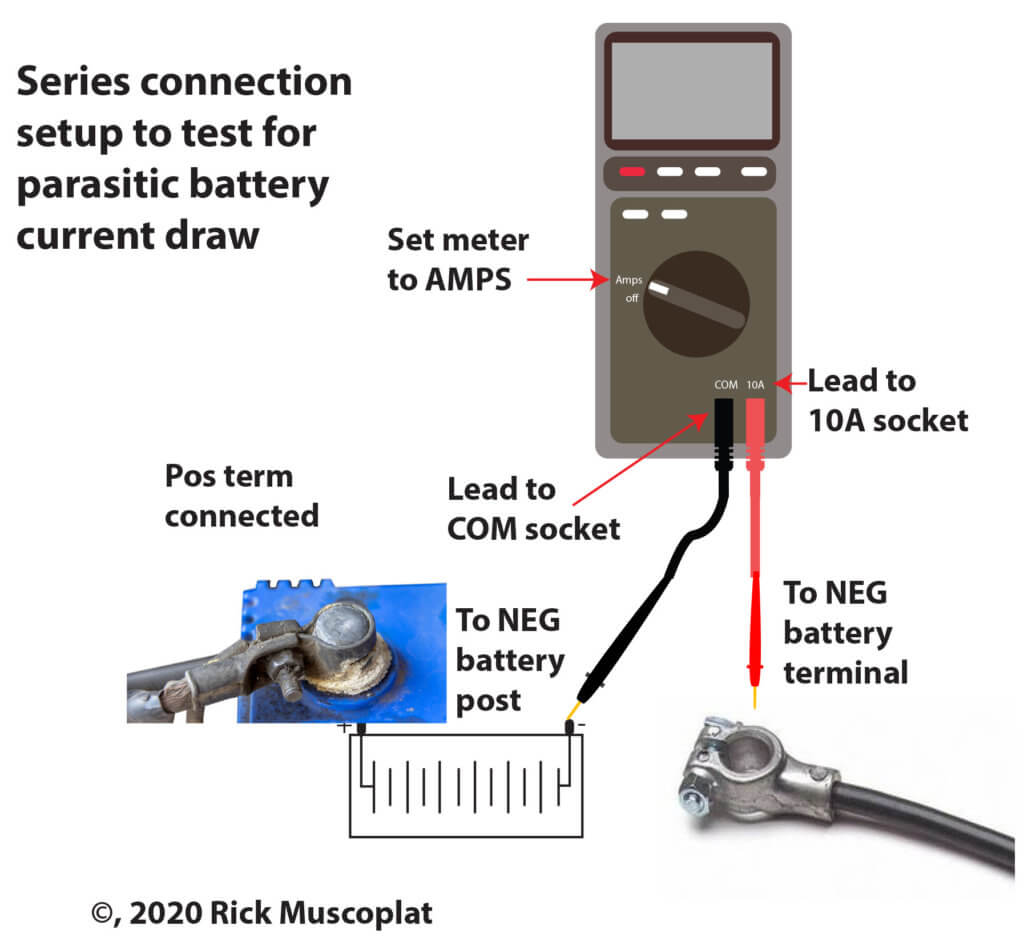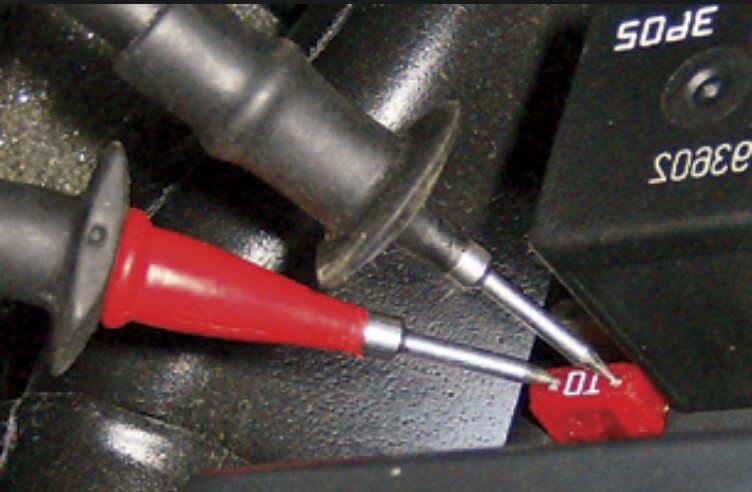How to perform a parasitic battery drain test
Parasitic battery drain test— How to
There are two ways to test for Parasitic battery drain test
Parasitic battery drain test method #1 Current draw testing for parasitic battery drain
In a current draw test you watch for a drop in current as you remove each fuse from the fuse box. If you pull a fuse and notice the current drop to less than 50-miliamps, you’ve identified the circuit with the problem. You can then examine which components on that circuit are the culprits.
You can use a multimeter to measure amps hooked in series to do this test or you can buy a low amp probe to do this test.
There are two problems with current draw testing
#1 Pulling fuses can cause problems
If you pull a fuse and don’t see a current drop you cannot reinstall the fuse until you’re completely done with your testing. If you reinstall the fuse, you’ll wake up any modules on that circuit, causing you to start the time out period all over again.
To avoid this, take a picture of the fuse box so you’ll know where each fuse goes. Then, pull the fuses one at a time and leave them out until you’ve tested all circuits.
#2 Using a multimeter connected in series can be an issue
To do a current draw test with just a multimeter, you must install the meter in series with the negative battery terminal. The instant you make the last connection, you’ll wake up all the modules in the vehicle and that can draw more than 10-amps; which will blow the 10-amp fuse in your multimeter.
In addition, some vehicles will activate the alarm system using a backup battery the instant the battery is disconnected. So the alarm will be blaring as you try and connect your meter in series. When you finally get it connected, you’ll still blow the fuse.
Parasitic battery drain testing for current draw using a multimeter and amp-clamp
• Leave battery terminals connected to the battery.
• Connect the low current amp clamp to the negative battery cable.
• With the key out of the ignition, let the vehicle sit for 15-45-mins to allow time for all computers to enter “sleep” mode.
• Note current draw. If the draw is above 50Ma, you have something drawing power.
• Remove one fuse at a time until the current draw falls below 50Ma. The fuse that causes the drop in the circuit causing the problem. Remember, if you’re doing a current draw test, you CANNOT put the fuse back in or you will wake up the modules on that circuit.
Test for current drain using a multimeter

• Disconnect the negative battery cable
• Set multimeter to lowest AMP setting
• Move one lead to the AMP socket on your meter
• Connect the other lead to the COM socket on your meter
• Connect one lead to the battery NEGATIVE post
• Connect the other lead to the negative battery terminal
• With the key out of the ignition, let the vehicle sit for 15-45-mins to allow time for all computers to enter “sleep” mode.
• Note current draw. If the draw is above 50Ma, you have something drawing power.
• Remove one fuse at a time until the current draw falls below 50Ma. The fuse that causes the drop is the circuit causing the problem
So the best way to do current draw testing is with a low amp probe.
If you’re going to do a parasitic battery drain test with current, use a clamp
The best way to conduct a current draw test is with a low amp clamp. You can get a free standing probe or an accessory probe that connects to your multimeter. Make sure it’s capable of reading miliamps. Low amp clamps are available as free standing units or add-on devices that connect to your existing multimeter
Or, you can use the amp reading feature on your multimeter. But there’s a downside to this approach. The multimeter amp fuse is usually only 10-amps and it can blow if you exceed that current draw. If accidentally wake up an module during the test, you’ll probably blow the fuse. If you choose this method, buy extra fuses so you can keep going.
Method #2 Use voltage drop testing for parasitic battery drain
In this method, you use a multimeter to check for voltage drop across each fuse. See the testing routine below.
Prepare the vehicle before testing
The computer modules must be in sleep mode before you can conduct a parasitic draw test. But since you’ll need access to the cabin fuse box during the test, you’ll need to open a door. That will automatically wake up the modules. So here’s what to do to prevent module wake-up.
Open all the doors, hatch, truck lid and hood
Trip the latch on each door by sliding a screwdriver into the latch to simulate the latch hitting the strike. That will trick the body control module into thinking all the doors are closed because most door switches are built into the latch mechanism.
Test for current drain using voltage drop and a multimeter
In this method you’ll use your multimeter to test the voltage drop across every fuse. You don’t pull fuses using this method. You just check for the fuse with the highest voltage drop. That will tell you which circuit is causing the parasitic battery drain.

1) Set your multimeter to the millivolt (mV) scale
2) Starting with the megafuses, connect the multimeter leads to the test point on each fuse. The mega-fuse with the largest voltage drop is the circuit that’s drawing the most power. Then test the smaller fuses in that circuit to find the one with the highest voltage drop. Keep in mind that some fuses have a constant voltage drop because they power keep-alive circuits (radio memory for example).
3) If there is no current flowing through the fuse, the meter will read 0-volts
4) If current is flowing through the fuse, you will get some reading. Refer to a voltage drop to amp conversion chart to determine current draw
5) Once you determine which circuit is drawing the most power, do NOT pull the fuse to that circuit. Instead, locate all the devices on that circuit and disconnect the devices one at a time until you see the change reflected in your readings.
©, 2020 Rick Muscoplat


